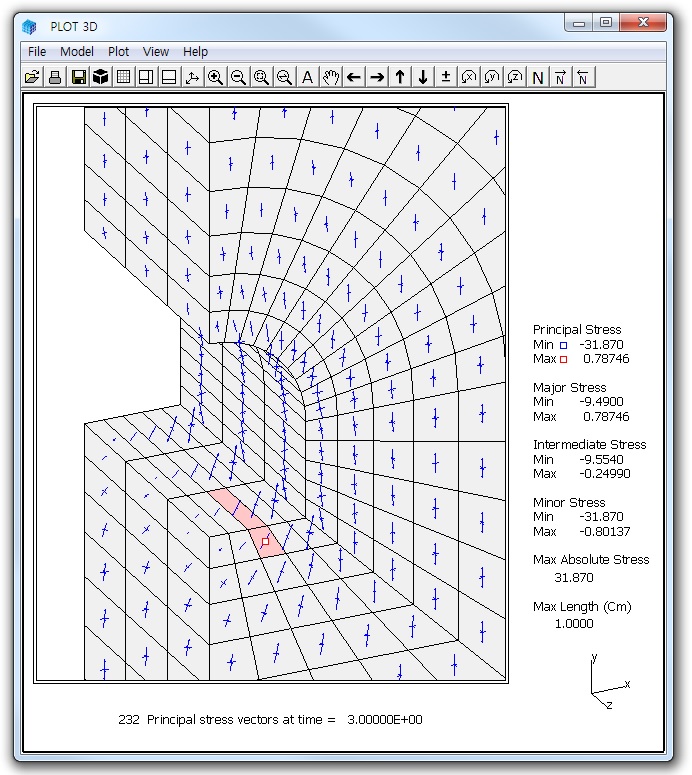Structure Medium Analysis Program
Static, Consolidation and Dynamic Analysis for Dry, Saturated and Partially Saturated Soils and Rock Mass
Both SMAP-2D and SMAP-3D are state-of-the-art multi-phase nonlinear finite element analysis programs
which can be applied to compute static, consolidation, or dynamic response of dry, saturated,
or partially saturated soils and porous rocks.
Both SMAP-2D and SMAP-3D have especially
useful features for earthquake analysis since they can continuously
perform the static analysis followed by dynamic analysis with
appropriate boundary change.
SMAP-2D is the 2-dimensional version which takes
account of spherical symmetry, plane strain and axisymmetry
configurations. And SMAP-3D is the 3-dimensional Version.
Over the last twenty years, the programs have been
continuously improved based on results of theoretical and
experimental research works. The programs can be a useful tool for
both research and practicing engineers to study geomechanical
response of saturated or partially saturated soils and porous
rocks.

Applications
-
Deformations, stresses and water flow around shafts, tunnels
and underground waste repositories during multi-staged construction
-
Slope stability analysis
-
Foundations and earth dam consolidations with prediction
of settlements and construction pore pressures
-
Dynamic soil structure analysis subjected to earthquake loading
-
Blast-induced liquefactions
-
Ground motions due to rock blasting
-
Wave propagation
-
Shell structures

Features
-
Nonlinear elastoplastic material models for
soils and porous rocks include Mohr-Coulomb, Drucker-Prager, Hoek
& Brown In Situ Rock Models, Duncan & Chang Hyperbolic
Model, Modified Cam Clay Model. JWL Model is available to model the explosive
charges.
-
Nonlinear flow equation includes both laminar
and turbulent flow terms such that at low flow velocity laminar
term governs and at high flow velocity, turbulent term governs.
The coefficient of permeability can be varied as a function of
current porosity.
-
Nonlinear compressibility properties of fresh
and sea waters are built-in in the programs. For partially
saturated porous materials, nonlinear compressibility of the air
is explicitly modeled.
-
Nonlinear compressibility equation of solid
grain is derived based on empirical linear relations between wave
velocity and particle velocity.
-
Dynamic sources include explosive charges,
pressure time histories, velocity time histories, initial
velocities and base accelerations.
-
Thermal expansion can be considered.
-
Transmitting and repeating boundaries can be specified.
-
Natural frequencies and mode shapes can be obtained.
-
Multi-staged excavation, construction or temporary support can be simulated.
-
Implicit or explicit time integration method can be used.
-
Joint element allows separation and sliding along the interface.
It can be used for modeling rock joints, fault zones, or structure-soil interfaces.
-
Truss element allows yielding, buckling and post-buckling.
It can be used for rock bolts and anchor bars.
-
Beam element allows axial, bending, torsion, and shear deformations.
-
Shell element allows bending, torsion, and membrane deformations.
-
Programs contain automatic node renumbering scheme to reduce bandwidth.

Geometry Modeling and Load Generation
SMAP programs contain following pre-processors
which make easier for finite element mesh and load generation:
- Group Mesh Generator
is a 2-dimensional CAD program to build group mesh
which can be used to generate finite element meshes with the aid of program ADDRGN-2D.
- Block Mesh Generator
is a 3-dimensional CAD program to build block mesh
which can be used to generate finite element meshes with the aid of program PRESMAP-GP.
- PRESMAP-2D
consists of four different models;
Model 1 for general shapes, Model 2 for near-fields around
underground openings, Model 3 for triangular and rectangular shape
geometry, and Model 4 for layered embankments having slope.
- NATM-2D
generates 2-dimensional finite element meshes and boundary conditions for typical NATM tunnels.
- CIRCLE-2D
generates 2-dimensional finite element meshes and boundary conditions for circular sections.
It can model three different options (quarter, half and full sections).
- JOINT-2D
generates jointed continuum finite element meshes given continuum SMAP-2D mesh file.
- LOAD-2D
generates 2-dimensional loads such as surface tractions, water pressures, specified velocities, etc.
- PRESMAP-GP
is the general purpose pre-processing program which generates line, surface,
and volume elements using rectangular, cylindrical, and polar coordinate systems.
- PRESMAP-3D
is the basic pre-processor which can be applied to model various types of 3D geometries.
- CROSS-3D
generates 3-dimensional finite element meshes and boundary conditions for crossing tunnels.
- PILE-3D
generates all input files required for 3-dimensional single pile analysis.
It can generate concrete pile with anchor bolts or steel pipe with concrete cap.
- JOINT-3D
generates jointed continuum finite element meshes given continuum SMAP-3D mesh file.
- INTERSECTION
programs compute the locations of the 3D surfaces crossing each other.
- GEN-3D
extends typical two-dimensional meshes to three-dimensional coordinate system.
- LOAD-3D
generates 3-dimensional loads such as surface tractions, water pressures, specified velocities, etc.
- ADDRGN
combines two different regions generated by pre-processing programs.
Graphical Output
Analysis results are interpreted graphically by
post processing programs (PLOT-2D, PLOT-XY and PLOT-3D)
PLOT-2D is used for the following 2-D plots:
- Finite element mesh with element or node numbers
- Principal stress distributions
- Deformed shapes/displacement vectors
- Truss axial force/stress/strain
- Beam section force/stress/strain
- Contours of stresses/strains/motions
PLOT-XY is used for the following time history plots:
- Stress/strain time histories
- Displacement/velocity/acceleration time histories
PLOT-3D is used for the following 2-D and 3-D plots:
- Mesh plots
- Deformed shapes
- Beam or truss section forces
- Isosurface plot for 3-D solid element
- Principal stress vectors for shell and continuum elements
- Contours for stresses, strains and displacements for shell and continuum elements

© Copyright Comtec Research 1998, all rights reserved
|